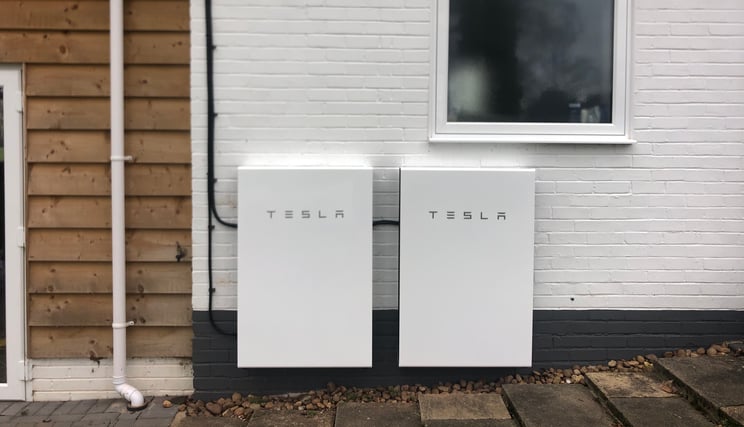Our Tesla rep Jerry came to our office this week to update us on the latest Powerwall 2 developments.
The most exciting thing? Timed charging and discharging is due to go live in January or Feburary 2018.
Why is this so exciting?
Thirty GigaWatts of older fossil fuel and nuclear capacity is due to be de-commissioned by 2025. At the same time, electrification of the transport system is proceeding at a steady pace. It is hardly surprising that the 'capacity margin‘, the buffer between electricity supply and demand, has been tightening.
But actually, the problem is not so much one of capacity, but one of matching demand with supply. That's where battery storage comes in. By managing the peaks and troughs much more efficiently, battery storage (alongside smart meters and more extensive time-of-use charging) is expected to enable UK PLC to carry on as normal with reduced overall peak power output, and reduced reliance on fossil fuels.
The traditional model of centralised energy generation is being replaced by a nimble, highly responsive and localised model of micro-generation and storage. A model in which local batteries, including electric vehicle batteries, store excess generation from wind and solar and feed back into the grid at times of peak demand. A model in which smart meters record the ebb and flow of electricity, allowing all of us to be the owners of our own mini power station.
A model in which those with battery storage buy cheap, and use peak....
The National Load Profile
Across the nation, electricity demand reaches a high in the late weekday afternoons (4-7pm), and then falls to a low overnight. Clearly the peak load is worse in winter than in summer.
To date most domestic properties have paid a single rate electricity tariff which doesn’t reflect the peaks and troughs of demand. Some domestic properties are on an Economy 7 (or Economy 10) tariff with a ‘peak’ rate (15p-20p per kWh) and an ‘off-peak’ rate (7-9 per kWh).
In January 2017, Green Energy UK introduced a ‘TIDE’ tariff with a banded tariff reflecting demand and supply across the nation and the true ‘underlying cost’ of electricity:
|
Time of Day |
Cost per kWh |
|
11pm – 6am (Mon-Fri) |
4.99p |
|
6am – 4pm (Mon-Fri) |
11.99p |
|
4pm – 7pm (Mon-Fri) |
24.99p |
|
7pm-11pm (Mon-Fri) |
11.99p |
|
11pm – 6am (Weekends) |
4.99p |
|
6am - 11pm (Weekends) |
11.99p |
With the advent of smart meters, able to record half hourly electricity use, the market will gradually witness the introduction of many more such ‘time-of-use’ tariffs.
Clearly there are large savings (up to 20p per kWh under ‘TIDE’) to be made by buying electricity at night and using it in the day. Powerwall 2 will offer this functionality from Q1 2018. It will be possible to specify fixed charge and discharge windows to make the most of differential import tariffs.
Existing Powerwall 2 owners will be able to access the functionality via a remote firmware upgrade.
Note that you don’t need a solar system to benefit from timed charging and discharging. We can all arbitrage the market, with or without panels on the roof.
What else did we learn from Tesla?
We had an update on the back-up: still on track for Q2 2018. Tesla tiles? Well they're on Tesla time...
Backup
From Q2 2018, Powerwall 2 will enable you to continue providing power to your home or business during power cuts. The system will switch automatically although the switch will not be to “UPS” (uninterrupted power supply) standard. Tesla claims that in general you won’t notice the switch (except via a text from Tesla), but don’t rely on the system if you have critical loads requiring seamless UPS standard back-up.
You will need to specify a reserve percentage (e.g. 30%) and the system will always keeps that percentage of the capacity in reserve for a power cut. This setting can be changed.
Solar PV will still work in a power cut. When the batteries are full, the system will ensure that the solar inverters power down if there is no load to utilise the excess solar.
The sizing of the Powerwall 2 means that with full backup power (5kW), with some judicious juggling, your life should continue undisturbed through the average power cut. That said, you should probably wait until the power comes on before using an electric dryer, and if you want to ensure you can continue to cook up a storm in the kithen, it’s probably best to install two Powerwalls.
If you reserve 30% of your battery (4kWh), then you should be able to watch TV, use your laptop and keep the lights and freezer working for almost four hours, whilst enjoying a few cups of coffee as you wait for the grid to be restored.
Typical loads are as follows:
Kitchen
- fridge / freezer: 500W;
- kettle: 3000W;
- oven: 3650W;
- induction hob: 1500W;
Office and entertainment
- laptop: 50W;
- TV: 80W;
Lighting
- average lighting load 500W (2500W all lights blazing for a typical 4 – 5 bed house (LED));
Laundry
- dishwasher: 1250W;
- washing machine: 500W;
- electric clothes dryer: 4000W.
Note that if you try and run more than the 5kW load limit, Powerwall 2 will stretch to 7kW for a few seconds, but after that you will see some ‘brown-out’ behaviour, as indeed you would if you tried to import more than your 100A supply from the grid under normal conditions.
If you have 3 phase electricity, it's worth downloading our guide to understand the functionality better.
We have updated our Powerwall 2 guide
Following some very helpful feedback from our customers (thanks in particular go to Mr B, who is a technical wizard and for sure would have done a much better job than we did in writing the guide in the first place...), and our visit from Jerry, we have updated our Tesla Powerwall 2 guide.
You can download the new improved version here:
|
Download new and improved Tesla Powerwall 2 guide |
 |
|










